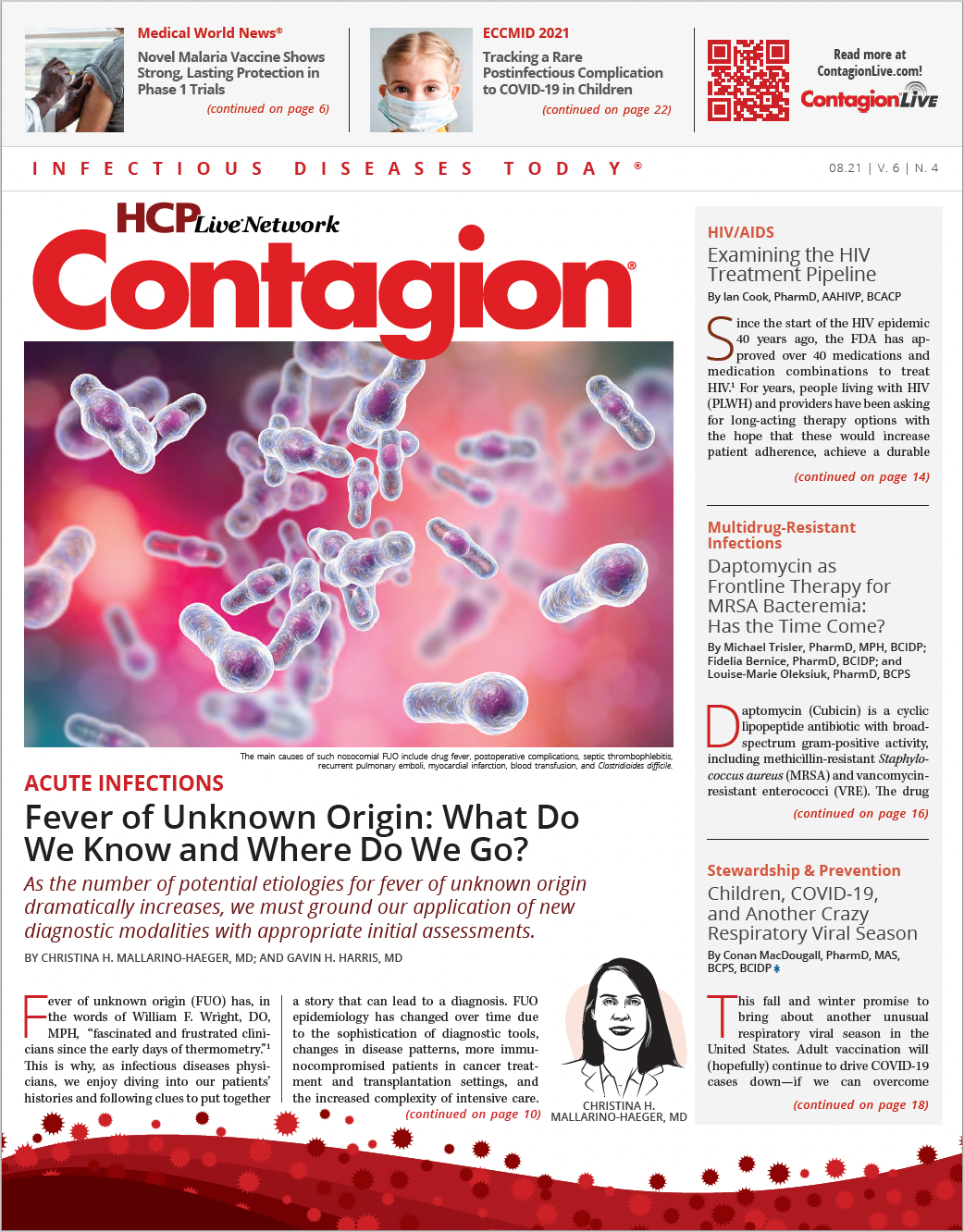Daptomycin as Frontline Therapy for MRSA Bacteremia: Has the Time Come?
Findings increasingly suggest the mortality risk may be reduced by initiating daptomycin within 3 days of infection.

Daptomycin (Cubicin) is a cyclic lipopeptide antibiotic with broad-spectrum gram-positive activity, including methicillin-resistant Staphylococcus aureus (MRSA) and vancomycin-resistant enterococci (VRE). The drug received additional FDA labeling for patients with S aureus bacteremia, including those with right-sided infective endocarditis, following the completion of a phase 3, randomized, double-blind clinical trial that found daptomycin to be noninferior to the standard of care.1
S aureus bacteremia is a heterogeneous entity. Treatment of methicillin-susceptible S aureus (MSSA) bacteremia with antistaphylococcal penicillin is associated with superior outcomes when compared with vancomycin.2,3 On balance, daptomycin is noninferior to the standard of care for S aureus bacteremia, which was defined as treatment with an antistaphylococcal penicillin or vancomycin. Notably, however, only 89 of 235 (38%) patients with S aureus bacteremia enrolled in the trial had bacteremia due to MRSA.4 The large number of patients with MSSA and the known superiority of antistaphylococcal penicillins make it difficult to extrapolate these conclusions to the efficacy of daptomycin vs vancomycin for MRSA bacteremia. Post hoc analyses further evaluated patient outcomes according to pathogen-specific therapy, and the efficacy of daptomycin was similar to both antistaphylococcal penicillin and vancomycin; however, the power to detect a significant difference was limited.5
Since these data were published in 2007, additional studies have been conducted whose results suggest a benefit to early daptomycin initiation in patients with MRSA bacteremia. Data from 2 matched, retrospective cohort studies found significantly lower 30-day mortality rates when daptomycin was initiated within 72 hours of MRSA bacteremia.6,7 Most recently, investigators from the Iowa City VA Health Care System also found that switching to daptomycin within 3 days of the initial receipt of vancomycin was associated with a lower 30-day mortality among patients with MRSA bacteremia. This benefit was not observed if patients were switched to daptomycin after 3 days.8
The retrospective review, published in Clinical Infectious Diseases, included 7411 patients from 124 VA hospitals with MRSA bacteremia who had initially received vancomycin. The investigators excluded patients who had died within the first 3 days of antibiotic treatment, been treated with another anti-MRSA antibiotic for at least 3 days prior to receiving vancomycin, had received vancomycin and daptomycin concomitantly for more than 24 hours, or received daptomycin before vancomycin. Six hundred six (8.2%) patients had been switched to daptomycin at any time during their first hospitalization. The median time to the switch was 6 days (interquartile range, 3-10 days), and 108 (1.5%) were switched within the first 3 days of the initial receipt of vancomycin. The authors elected to use a 3-day time period for switching because of prior clinical trial recommendations which suggest that fewer than 3 days of alternative therapy is unlikely to impair the ability to attribute patient outcomes to the antibiotic of interest.9
When compared with patients who remained on vancomycin, those who switched to daptomycin were significantly more likely to have a vancomycin minimum inhibitory concentration (MIC) of 2 mcg/mL or greater, experience acute kidney injury (AKI), osteomyelitis, or endovascular infection, have an infectious diseases physician consult, and have a higher mean body mass index. Patients who switched to daptomycin early in treatment were also younger and more likely to receive therapy with a concomitant anti-MRSA antibiotic, particularly linezolid (2.5% vs 0.2%; P < .001) but not ceftaroline (1.7% vs 0.9%; P = .48). After adjusting for these findings between group differences and other potential confounders, patients who switched to daptomycin within 3 days were less likely to die within 30 days (HR, 0.48; 95% CI, 0.25-0.92). Importantly, the mortality risk reduction was only observed for those who switched to daptomycin within 3 days. There was no significant difference after adjustment when comparing patients who remained on vancomycin with those who switched to daptomycin at any point during their initial hospitalization (HR, 0.87; 95% CI, 0.69-1.09).
Since its FDA approval in 1958, vancomycin has been widely prescribed and is recommended as first-line therapy for patients with patients with MRSA bacteremia.10 The use of vancomycin requires therapeutic drug monitoring to both maximize efficacy and reduce the risk of AKI. The clinical and economic impact of AKI is significant, as noted in the vancomycin dosing guidelines, which state: “many patients, especially those who are critically ill, do not fully recover renal function after AKI,and even mild AKI can significantly decrease long-term survival rates, increase morbidity, prolong hospitalizations, and escalate healthcare costs.”11-14
A meta-analyses by van Hal and colleagues reported the prevalence of vancomycin-associated AKI to range between 5% to 43%. Vancomycin trough concentrations of 15 mg/L or greater were associated with a significantly increased odds of AKI compared to trough concentrations below 15 mg/L (odds ratio [OR], 2.67; 95% CI, 1.95-3.65).15 Accordingly, updated vancomycin dosing guidelines now recommend that area under the curve (AUC)-guided dosing be performed, which is associated with a lower risk of vancomycin-associated AKI.16 Although transitioning to AUC-guided dosing may lower AKI rates, it requires implementing additional laboratory and clinical resources.
Daptomycin’s once-daily dosing, lack of required therapeutic drug monitoring, and favorable tolerability profile make it a desirable candidate for patients with MRSA bacteremia, who often require prolonged courses of therapy. The potential advantages of daptomycin have been historically offset by its high cost; however, the FDA approved the generic formulation in 2019 and the acquisition costs have decreased significantly.17 These factors, coupled with a mortality benefit when initiated early,6-8 should prompt clinicians to reconsider vancomycin as first-line therapy for MRSA bacteremia and shift to the early initiation of daptomycin.
The preferential use of daptomycin warrants consideration of potential collateral effects. Most notably, VRE has a paucity of treatment options, and increased use of daptomycin could potentially result in greater selective pressure for daptomycin-resistant VRE. Switching to daptomycin may have many potential benefits, but current data suggest the mortality benefit for MRSA bacteremia is predicated on the drug’s early use, rather than waiting for persistent disease, treatment failure, or toxicity with vancomycin. Furthermore, concerns related to vancomycin-associated nephrotoxicity may not be as prudent if utilizing an early switch approach in these patients, as most episodes develop after at least day 4 of therapy.11 To this end, we favor daptomycin initiation once MRSA bacteremia has been identified rather than as empiric therapy or based on gram stain results.
In light of the current evidence, antimicrobial stewardship programs (ASPs) should consider developing criteria targeting the early switch to daptomycin in specific patient populations with MRSA bacteremia. Patients who may benefit the most include those who lack pulmonary involvement and are critically ill (eg, septic shock), those who have complicated infections (eg, endocarditis), or those who are at greater risk for vancomycin-associated AKI (eg, elderly patients, those with baseline chronic kidney disease). Daptomycin may also be preferred in patients with MRSA isolates possessing reduced susceptibility to vancomycin, those with limited intravenous access, and patients who have difficulty obtaining therapeutic vancomycin concentrations or have fluctuating renal function. Real-time alerts via the electronic health record, third-party software, or the microbiology laboratory may assist ASPs with the timely identification of these patients. Additionally, ASP collaboration with the microbiology laboratory can be used to promote the implementation of rapid diagnostics that allow for earlier identification of the organism and resistance patterns.
References
- Cubicin. Prescribing information. Merck Sharp & Dohme Corp; 2021. Accessed June 25, 2021 https://www.merck.com/product/usa/pi_circulars/c/cubicin/cubicin_pi.pdf
- Chang FY, Peacock JE Jr, Musher DM, et al. Staphylococcus aureus bacteremia: recurrence and the impact of antibiotic treatment in a prospective multicenter study. Medicine (Baltimore). 2003;82(5):333-339. doi:10.1097/01.md.0000091184.93122.09
- Siegman-Igra Y, Reich P, Orni-Wasserlauf R, Schwartz D, Giladi M. The role of vancomycin in the persistence or recurrence of Staphylococcus aureus bacteraemia. Scand J Infect Dis. 2005;37(8):572-578. doi:10.1080/00365540510038488
- Fowler Jr VG, Boucher HW, Corey GR, et al; S. aureus Endocarditis and Bacteremia Study Group. Daptomycin versus standard therapy for bacteremia and endocarditis caused by Staphylococcus aureus. N Engl J Med. 2006;355(7):653-665.
- Torres-Tortosa M, Caballero-Granado FJ, Canueto J. Therapy for methicillin-resistant Staphylococcus aureus. N Engl J Med. 2006;355(20):2153-2155.
- Claeys KC, Zasowski EJ, Casapao AM, et al. Daptomycin improves outcomes regardless of vancomycin MIC in a propensity-matched analysis of methicillin-resistant Staphylococcus aureus bloodstream infections. Antimicrob Agents Chemother. 2016;60(10):5841-5848. doi:10.1128/AAC.00227-16
- Murray KP, Zhao JJ, Davis SL, et al. Early use of daptomycin versus vancomycin for methicillin-resistant Staphylococcus aureus bacteremia with vancomycin minimum inhibitory concentration >1 mg/L: a matched cohort study. Clin Infect Dis. 2013;56(11):1562-1569. doi:10.1093/cid/cit112
- Schweizer ML, Richardson K, Vaughan Sarrazin MS, et al. Comparative effectiveness of switching to daptomycin versus remaining on vancomycin among patients with methicillin-resistant Staphylococcus aureus (MRSA) bloodstream infections. Clin Infect Dis. 2021;72(suppl 1):S68-S73.
- Holland TL, Chambers HF, Boucher HW, et al. Considerations for clinical trials of Staphylococcus aureus bloodstream infection in adults. Clin Infect Dis. 2019;68:865-872. doi:10.1093/cid/ciaa1572
- Liu C, Bayer A, Cosgrove SE, et al. Clinical practice guidelines by the Infectious Diseases Society of America for the treatment of methicillin-resistant Staphylococcus aureus infections in adults and children. Clin Infect Dis. 2011;52(3):e18-e55. doi:10.1093/cid/ciq146
- Rybak MJ, Le J, Lodise TP, et al. Therapeutic monitoring of vancomycin for serious methicillin-resistant Staphylococcus aureus infections: a revised consensus guideline and review by the American Society of Health-System Pharmacists, the Infectious Diseases Society of America, the Pediatric Infectious Diseases Society, and the Society of Infectious Diseases Pharmacists. Am J Health Syst Pharm. 2020;77(11):835-864. doi:10.1093/ajhp/zxaa036
- Singbartl K, Kellum JA. AKI in the ICU: definition, epidemiology, risk stratification, and outcomes. Kidney Int. 2012;81(9):819-825. doi:10.1038/ki.2011.339
- Neely MN, Kato L, Youn G, et al. Prospective trial on the use of trough concentration versus area under the curve to determine therapeutic vancomycin dosing. Antimicrob Agents Chemother. 2018;62(2):e02042-17.
- Linder A, Fjell C, Levin A, Walley KR, Russell JA, Boyd JH. Small acute increases in serum creatinine are associated with decreased long-term survival in the critically ill. Am J Respir Crit Care Med. 2014;189(9):1075-1081. doi: 10.1128/AAC.02042-17
- van Hal SJ, Paterson DL, Lodise TP. Systematic review and meta-analysis of vancomycin-induced nephrotoxicity associated with dosing schedules that maintain troughs between 15 and 20 milligrams per liter. Antimicrob Agents Chemother. 2013;57(2):734-744. doi:10.1128/AAC.01568-12
- Aljefri DM, Avedissian SN, Rhodes NJ, Postelnick MJ, Nguyen K, Scheetz MH. Vancomycin area under the curve and acute kidney injury: a meta-analysis. Clin Infect Dis. 2019;69(11):1881-1887. doi:10.1093/cid/ciz051
- 2019 First generic drug approvals. Food and Drug Administration. Updated February 14, 2020. Accessed 26 May 2021. https://www.fda.gov/drugs/first-generic-drug-approvals/2019-first-generic-drug-approvals

